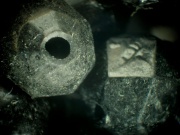Difference between revisions of "Glass rot"
(username removed) |
|||
| Line 2: | Line 2: | ||
== Description == | == Description == | ||
| − | Any of several processes that result in the decay of [ | + | Any of several processes that result in the decay of [[glass]]. Glass decay processes may be due to improper original glass composition or from deleterious environmental conditions. Symptoms can include [[weeping]], [[delamination]], crizzling, [[devitrification]], and weathering crusts. Weeping, or the formation of liquid on the surface, is associated with excess [[alkali]] in the glass formulation. The glass matrix can change over time in moist environments with [[water]] and [[oxygen]] molecules penetrating into the glass or ions migrating to the surface. This can result in microscopic voids, shrinkage, and crizzling. Crizzling produces a hazy appearance due to the formation of fine, internal cracks. Devitrification, or sugaring, of the glass can also be a result of excess lime in the formulation. |
[[File:Glassrot_black.jpg|thumb|Glass rot]] | [[File:Glassrot_black.jpg|thumb|Glass rot]] | ||
| + | |||
== Synonyms and Related Terms == | == Synonyms and Related Terms == | ||
Revision as of 09:26, 16 January 2014
Description
Any of several processes that result in the decay of Glass. Glass decay processes may be due to improper original glass composition or from deleterious environmental conditions. Symptoms can include Weeping, Delamination, crizzling, Devitrification, and weathering crusts. Weeping, or the formation of liquid on the surface, is associated with excess Alkali in the glass formulation. The glass matrix can change over time in moist environments with Water and Oxygen molecules penetrating into the glass or ions migrating to the surface. This can result in microscopic voids, shrinkage, and crizzling. Crizzling produces a hazy appearance due to the formation of fine, internal cracks. Devitrification, or sugaring, of the glass can also be a result of excess lime in the formulation.
Synonyms and Related Terms
sick glass; crizzling; devitrification; weeping glass; microfissuração do vidro (Port.)
Hazards and Safety
The moisture on weeping glass may cause potential damage to nearby adjacent materials, especially in a closed microenvironment.
Additional Information
R.Newton, S.Davison, Conservation of Glass, Butterworth-Heineman, London.
Additional Images
Authority
- External source or communication Comment: Perconal communication: Laurent Sozzani, August 2004.


